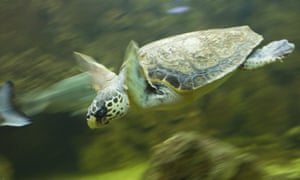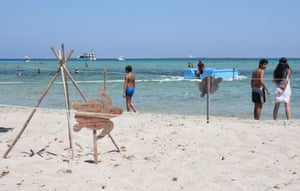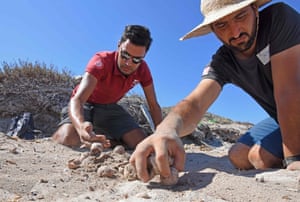Years of marine conservation efforts throughout the Mediterranean are beginning to pay dividends in Tunisia, with activists expecting a further increase in the number of sea turtles visiting the country’s beaches to build their nests this year.
It’s an unlikely, albeit fragile, victory. Many of the factors that pushed sea turtles on to the world’s endangered list are still present and continue to threaten the survival of the species. However, activists monitoring sea-turtle nests on Kuriat Island, a vital nesting ground, have reported an increase in nests from 11, when they first started monitoring in 1997, to more than 40 annually.
“Sea turtles are what we call a keystone species,” says Jamel Jrijer, a marine project manager at the WWF’s offices in Tunis. “That’s to say, they play a critical role in making the marine environment what it is.”
Of the three species of sea turtle – green, leatherback and loggerhead – that are encountered in Tunisian waters, it is only the loggerhead that nests here. It lays its eggs at just a tiny number of sites, with Kuriat Island near Monastir, a popular destination for day trippers, being the most important.

Heavy fishing – which often sees turtles trapped in lines and nets – plus the waste pumped from Gabes’s industrial heartland (estimated at about 13,000 tonnes of phosphate daily), had combined with plastics and other debris to push the Mediterranean’s loggerhead turtle population to the brink.
Undercutting it all are the twin threats of global heating and a cultural tradition that prizes turtle’s meat as a source of traditional medicine over their contribution to the health of the sea.
However NGOs, along with the Tunisian government, have pushed back, protecting the nesting grounds on Kuriat since 1997 and establishing the Sea Turtle Rescue Centre at the National Institute of Marine Sciences and Technologies in Monastir in 2004.
Marine biologist Imed Jribi, speaking from his home in the coastal town of Chebba, is delighted to discuss his work on Kuriat. “When I first started work here in 1997 there were only 11 nests,” he says. “Now we are seeing between 40 and 45 nests every year.”
However, tourism still presents major problems. “We have too many people visiting Kuriat,” Jribi says. “We need smaller groups, which will allow us to manage them and protect the turtles’ nesting areas,” he says. Other problems can arise, he explains, for example with the hatchlings at Chebba, whose instinct to navigate to the sea by the moon is subverted by the cafes and roadside lights, which draw the baby turtles towards the lethal streets.
Loggerhead turtles return to Tunisia’s beaches sporadically, sometimes leaving two to three years between visits. Once on the beach, the female turtle will build three or four nests, into each of which – if left undisturbed – she will lay 80 to 120 eggs. However, despite their numbers, the odds of the young turtle’s survival are already slim. Small, vulnerable and with shells barely formed, only a tiny fraction of those born on the sands of Tunisia will ever reach sexual maturity.

If the resurgence in Tunisia’s nesting grounds is a success story, it is a qualified one. Turtles trapped in fishing nets and lines are still clandestinely sold for meat at some fish markets along Tunisia’s coast. While most agree that this illegal practice is diminishing, it is impossible to say by how much. However, the increasing numbers of turtles being taken to the Sea Turtle Rescue Centre by fishermen and the general public gives some cause for hope.
“Most of the turtles we see have been injured through contact with fishing gear,” chief biologist Olfa Chaieb says. “The trawlers [which rake the sea floor] do particular damage, destroying the posidonia seagrass, which is an important source of food for sea turtles, as well as providing a habitat for other forms of marine life. Because of the turtle’s dependence on air, they can drown once they become entangled in nets underwater.”
Further cause for concern is discarded plastic; sea turtles often mistake floating plastic bags for jellyfish, a staple of the their diet. “About 50% of the turtles we see have plastic within their system. That’s not including the microplastics that we can’t detect,” says Chaieb.

Given the obstacles, including rising sea temperatures affecting turtles’ gender (more females are born the warmer it is), the increase in turtles is all the more remarkable.
As Tunisia gradually emerges from lockdown, local tourists are returning to empty beaches, just as the turtles are revisiting their birthplaces. Both have faced hard times. Both are looking forward to a more hopeful future.